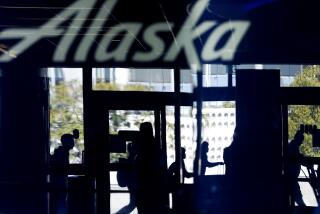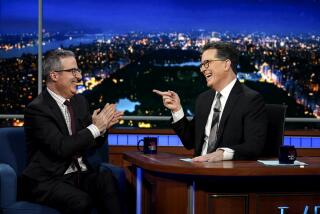United Predicts Service to Be Restored by July 1 : Gears Up to Resume All Its Flights After Accord in Pilot Strike
- Share via
United Airlines, having settled its first pilot strike in 34 years, predicted Saturday that by July 1 it will “virtually fully restore” all of the service that was crippled by the 29-day walkout.
United President James Hartigan said the airline, which was able to fly only about 14% of its 1,550 domestic and international routes during the strike, would be flying 33% of its schedule by Thursday and 40% by June 25.
United’s Apollo computer reservation service informed travel agents Saturday that achieving 100% service could require three to four weeks. But Alan Wayne, a corporate spokesman in Los Angeles, described that as an “outside estimate” and said that most flights would be operating by the end of the month.
Discounts Expected
Industry analysts said they expect United to quickly offer travel discounts in an effort to lure back customers who flew other airlines during the strike.
In the weeks after a 1979 mechanics strike that had shut United down completely for 58 days, the airline issued 2.5 million discount coupons entitling ticket buyers to half-price fares on their next flight anywhere in the country.
Hartigan said the airline would emphasize restoring as rapidly as possible service to Hawaii, to which United normally carries half of the visitors from the mainland.
Hawaii’s lieutenant governor last week had warned that hotels and restaurants in his state would soon begin laying off substantial numbers of workers unless the strike ended.
United spokesman Joe Hopkins said the company was satisfied with the back-to-work agreement that was signed early Saturday morning. Roger Hall, chairman of the Air Line Pilots Assn.’s Master Executive Council, said pilots had “won a major strike” and predicted that a federal court judge in Chicago responsible for resolving the key back-to-work arguments under the terms of the settlement will rule in the pilots’ favor.
Complex Mechanics
The strike by United’s 5,200 pilots was ended by the same kind of complex mechanics that had prolonged it.
By Friday night, the pilots’ Master Executive Council had decided to accept the back-to-work agreement, which had been negotiated earlier in the week. But pilots were determined not to formally vote until the Assn. of Flight Attendants, which honored the pilots’ picket line, had negotiated its own back-to-work agreement with United.
Pilots said they wanted to make sure that striking flight attendants suffered no penalties.
However, three days of meetings between the flight attendants and United produced no compromise. United officials also were warning that they might not honor their agreement with the pilots after Saturday.
That stalemate was broken only when leaders of the flight attendants’ union decided late Friday night to return to work without reaching a settlement.
Seniority an Issue
The attendants contended that United was blocking a settlement by insisting on giving seniority preferences to flight attendants who had crossed the picket line or were hired after the strike.
That constituted “savage reprisals” against strikers, said Pat Friend, chairwoman of the flight attendants’ Master Executive Council. United officials refused to comment Saturday.
In agreeing to return to work, the attendants freed the pilots’ union of its promise to wait for a separate settlement. Hours later, officials of the pilots’ union and United signed the back-to-work agreement.
In the wake of the back-to-work agreement, pilots are expected to return to their old jobs as soon as their flights are resumed. But the attendants are another matter, United spokesman Wayne said. He noted that the airline had hired 500 replacement flight attendants during the strike and that, until a court directs the airline to do otherwise, attendants who struck will be called back “as there are vacancies.” Attendants with the least seniority could be kept on inactive duty even after all flights are restored, Wayne said.
The attendants predicted that their demand that seniority rosters be restored to pre-strike conditions would be upheld in the coming trial of the lawsuit in Chicago, which their union filed in May, charging United with bad-faith bargaining.
To Be Settled by Judge
The same seniority question was responsible for stalling settlement of the pilots’ back-to-work agreement during the last three weeks. It was only when negotiators for United and the pilots agreed to let that question be settled by U.S. District Judge Nicholas Bua that the tentative agreement was reached on Wednesday.
On Monday, Bua will begin trial of the pilots’ bad-faith bargaining suit against United. The back-to-work agreement calls on him to settle another key dispute: whether 566 pilot trainees who were trained before the strike, but refused to report for work when it began, should be considered United employees. The airline had vowed never to hire the trainees.
The main economic provision of the strike, a two-tier wage scale to limit salaries of new pilots, was settled after the first week of the strike. It calls for newly hired pilots to be paid substantially less than currently employed pilots during the first five years of employment.
The question of whether newly hired pilots’ wages should match other pilots’ wages after five years’ employment, or whether they should be kept low for several more years, was left open for discussion in 1988, when the new contract expires.
More to Read
Inside the business of entertainment
The Wide Shot brings you news, analysis and insights on everything from streaming wars to production — and what it all means for the future.
You may occasionally receive promotional content from the Los Angeles Times.









